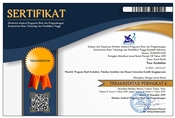RESILIENSI TERHADAP BENCANA BANJIR DAN TOPAN DI KOTA NAGA: PENDEKATAN BUDAYA SEBAGAI SOLUSI DESAIN
Abstract
Abstract
Natural disasters like floods and hurricanes happens often in Philippines, causing damage to public infrastructure and agricultural land. Naga City, a growing city in Philippines, is no exception. The disaster recovery process is often iterative and works top-down, so that the provided help is only temporary and inefficient. This lack of efficiency is caused by the non- involvement of the community during planning process. The problem can be solved by implementing cultural strategy and community involvement in recovery process to increase community resilience. The local spirit of mutual assistance, bayanihan, is widely spread throughout Naga City’s social culture. The Barangay Hall, a space that serves as administrative office and public space, is where the community gathers. The cultural potential of Naga City’s community is explored to design post-disaster facility. This study aims to find elements of local culture that can be applied in post-disaster building design. Through literature review, this study incorporates bayanihan culture and disaster-resilient building principles to propose a new type of Barangay Hall as a post-disaster facility. This study produced a Barangay Hall design that accommodates activities to improve community-building, providing safe place during emergency, and is independently self-supporting.
Keywords:
Natural Disasters, Evacuation Center, Resilience, Philippines, Cultural approach
Abstrak
Filipina sering mengalami bencana alam, seperti banjir dan angin topan, yang mengakibatkan kerusakan pada infrastruktur publik dan lahan pertanian. Hal ini juga dialami oleh Kota Naga, kota yang sedang berkembang di Filipina. Proses pemulihan pascabencana seringkali dilakukan secara terpusat dan menggunakan pendekatan top-down, sehingga terkadang bantuan yang diberikan hanya beroperasi pada kurun waktu tertentu saja dan selanjutnya terbengkalai. Ketidakefisienan tersebut timbul akibat tidak adanya partisipasi masyarakat dalam proses pemulihan pascabecana. Pendekatan budaya yang melibatkan masyarakat pada proses pemulihan lebih ideal untuk mewujudkan resiliensi masyarakat. Di Kota Naga sendiri, masyarakat memiliki semangat gotong-royong yang kuat, yang disebut bayanihan. Budaya masyarakat tersebut tercermin dalam tipologi bangunan khas lokal, Barangay Hall, yang berfungsi sebagai kantor administrasi dan tempat kegiatan komunal. Pada studi ini, potensi budaya Kota Naga akan dieksplorasi untuk merancang fasilitas pascabencana berupa bangunan pusat evakuasi. Melalui kajian literatur, studi ini memasukkan budaya bayanihan dan prinsip-prinsip bangunan tanggap bencana untuk mengusulkan tipologi Barangay Hall yang baru sebagai fasilitas pascabencana. Studi ini menghasilkan perancangan Barangay Hall yang mewadahi kegiatan komunitas untuk meningkatkan kerja sama masyarakat, memberikan tempat yang aman untuk berlindung saat evakuasi, serta mampu mendukung keberlanjutan bangunan dan lingkungan secara mandiri.
Keywords
Full Text:
PDFReferences
Companion, M., ed. (2015). Disaster's Impact on Livelihood and Cultural Survival: Losses, Opportunities, and Mitigation. CRC Press.
Ericleroy P. (2021). Hasil wawancara pada tanggal 6 April 2021.
Hechanova, M. R. M., Waelde, L. C., & Ramos, P. A. P. (2016). Evaluation of a group-based resilience intervention for Typhoon Haiyan survivors. Journal of Pacific Rim Psychology, 10. https://doi.org/10.1017/prp.2016.9
ICLEI (ICLEI – Local Governments for Sustainability). (2014). ICLEI Local Governments for Sustainability Annual Report 2014.
Krüger, F., Bankoff, G., Cannon, T., Orlowski, B., & Schipper, E. L. F. (Eds.). (2015). Cultures and disasters: understanding cultural framings in disaster risk reduction. Routledge.
Miller, D. S., & Rivera, J. D. (2011). Introduction: the unique opportunities and challenges from a social scientific perspective. In Community Disaster Recovery and Resiliency: Exploring Global Opportunities and Challenges (pp. XXXV-li). CRC Press London, New York.
Mooneghi, M. A., & Kargarmoakhar, R. (2016). Aerodynamic mitigation and shape optimization of buildings. Journal of building engineering, 6, 225-235. https://doi.org/10.1016/j.jobe.2016.01.009
Opdyke, A., Javernick-Will, A., Koschmann, M., & Moench, H. (2016). Characterizing Post-Disaster Shelter Design and Material Selections: Lessons from Typhoon Yolanda in the Philippines. American Society of Civil Engineers.
Ravina, D., & Shih, R. R. (2017). A shelter for the victims of the Typhoon Haiyan in the Philippines: The design and methodology of construction. Pollack Periodica, 12(2), 129-139.
Stephenson, V., Finlayson, A., & Miranda Morel, L. (2018). A risk-based approach to shelter resilience following flood and typhoon damage in rural Philippines. Geosciences, 8(2), 76.
Surtiari, G. A. K., Djalante, R., Setiadi, N. J., & Garschagen, M. (2017). Culture and community resilience to flooding: Case study of the urban coastal community in Jakarta. Disaster risk reduction in Indonesia. (pp. 469-493). Springer, Cham.
Swidler, A. (1986). Culture in action: Symbols and strategies. American sociological review, 273-286. https://doi.org/10.2307/2095521
Swidler, A. (2008). Comment on Stephen Vaisey's" Socrates, Skinner, and Aristotle: Three Ways of Thinking about Culture in Action". In Sociological Forum (pp. 614-618). Blackwell Publishing.
Swidler, A. (2013). Talk of Love: How Culture Matters. University of Chicago Press.
City Government of Naga (2012). City Planning and Development Office Naga City Comprehensive Development Plan. Diunggah pada tanggal 5 Agustus 2021. https://www2.naga.gov.ph/wp-content/uploads/2022/07/CDP-2011-20-Final-Preliminary-Pages.pdf
City Government of Naga (2020). Comprehensive Land Use Plan (CLUP) for the City of Naga 2016-30. Diunggah pada tanggal 5 Agustus 2021. https://www2.naga.gov.ph/wp-content/uploads/2022/07/CLUP-2016-30-Naga-City.pdf.
DOI: https://doi.org/10.24167/tesa.v20i2.4591
ISSN 1410-6094 (Print) | ISSN 2460-6367 (Media Online) | View My Stats

This work is licensed under a Creative Commons Attribution 4.0 International License.








